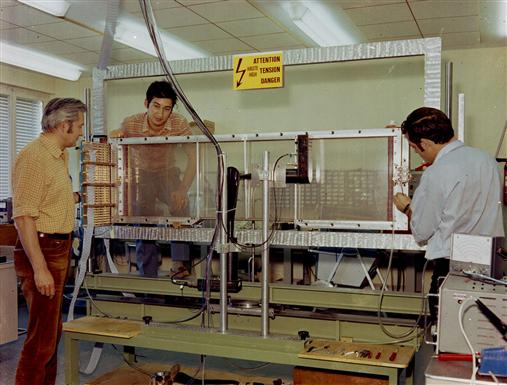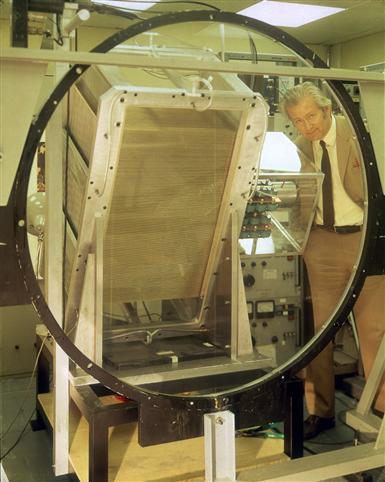CERN70: An electronic revolution
16 May 2024 · Voir en français
Part 9 of the CERN70 feature series. Find out more: cern70.cern
Georges Charpak received the 1992 Nobel Prize in Physics for his 1968 invention
of the multi-wire proportional chamber, which revolutionised particle detection

Progress in fundamental particle physics research often relies on developing ever more precise detectors with increased reaction times and covering increasingly larger surfaces. Early detectors at CERN fulfilled only part of these requirements. They were mainly based on photographic methods unsuitable for studying rare particle interactions, where only a few interesting events must be selected out of millions observed. It was necessary to increase the speed of data collection dramatically.
In 1968, Georges Charpak used an earlier development, the proportional counter, to build a new kind of detector, the “multiwire proportional chamber”. In a proportional counter, an electrical voltage is applied to the terminals of a gas-filled tube with a central wire running through it. As particles pass through, the gas is ionised, triggering a chain reaction that generates an electrical signal on the wire. This signal is used to determine the location of the first ionisation.
Instead of a tube and a single wire, Charpak’s idea was to use a gas-filled enclosure containing many parallel detection wires. Each wire connects to a transistor amplifier and acts as an independent proportional counter. This device, linked to a computer, achieved a counting speed a thousand times faster than the detectors of the time and a spatial resolution of the order of a millimetre. A later development, the drift chamber, achieved an even better spatial resolution of fractions of a millimetre. Charpak’s invention revolutionised particle detection, bringing it into the electronic age.
Today practically every experiment in particle physics uses some type of track detector based on the principles of multiwire proportional chambers. These kinds of detectors are also used in many other fields, such as biology, radiology and nuclear medicine.
Recollections
Detector research in high-energy physics can be a source of important achievements for other fields – if experienced people have the freedom also to tackle problems not directly connected with the main goal of their laboratories.
Georges Charpak

Georges Charpak joined CERN in 1959. During his career, he worked on various experiments and developed numerous detectors that had a fundamental impact on particle physics. In 1992, he was awarded the Nobel Prize in Physics for his invention and development of particle detectors, in particular the multiwire proportional chamber.
“I almost never started to study a detector without having to solve a problem for my own experiments or, very often, to overcome difficulties confronting the community in which I was working. One of these problems, in the 1960s, was that the master tools in particle physics, the bubble chambers, were reaching a bottleneck. With about 10 million pictures taken every year, the high-energy physics community around the world reached the maximum possible amount of photographs that could be reasonably treated by human examination.
Other detectors, the spark chambers, could be triggered by fast detectors to select interactions imbedded in a large flow of uninteresting ones, but this technique reached the same limit of millions of pictures to analyse. This is when I left a successfully completed experiment, the measurement of the muon magnetic moment, for which I had come to CERN, and thought of a method to retrieve the position of a spark in a spark chamber without having to take a picture […].
The revolution in transistor amplifiers permitted the conception of a new idea […]. With the experience I had gained earlier in the construction of single-wire proportional counters for my thesis in low energy nuclear physics, I conceived a small chamber of 10 by 10 centimetres with simple ingredients that made each wire operate in the same conditions as in a single wire proportional counter. When I tested the chamber, I observed pulses proportional to the energy lost in the gas by traversing particles, with several properties opening the door to innovative detectors: the pulses on the anode wires were not due to the collection of the electrons of the avalanches, but to the motion of the positive ions inducing pulses of opposite polarity on the neighbouring wires. This made it easy to identify the wire collecting the avalanche. A counting rate of one million pulses per second, 1000 times larger than the one reached with spark chambers could easily be obtained.
The pulses were delayed with respect to the initial particles by a time of a few nanoseconds, which easily allowed measurement of the distance of the trajectory to the wire. This opened the way to another major advance: the drift chambers, which permitted the construction of large detecting surfaces with a small number of electronic channels and accuracies of the order of 100 microns. The positive induced pulses on the cathodes permitted the construction of two-dimensional detectors, essential for the localization of X-rays or neutrons.
I started to be also interested in the application of detectors to fields outside particle physics. In 1974, my group, in collaboration with Saclay, undertook the exploration of the human body with high energy particle beams. With wire chambers giving the position of incoming and outgoing particles, we had the idea of mapping the three-dimensional density distribution inside a living body without having to rotate either the source, the body or the detector. After good first results, we halted the project since no low-cost accelerators for this application were in view.
Nevertheless, the existence of groups active in detector research in high-energy physics can be a source of important achievements for other fields – if experienced people have the freedom also to tackle problems not directly connected with the main goal of their laboratories. Valuable solutions in many domains can probably result from the effort to build low-cost, high-rate, high-accuracy particle detectors required by the next generation of accelerators.”
----
This interview is adapted from the 2004 book “Infinitely CERN”, published to celebrate CERN’s 50th anniversary. Georges Charpak passed away in 2010 at the age of 86, read a tribute to him in the CERN Courier.
